battery TOYOTA iQ EV 2013 Owners Manual (in English)
[x] Cancel search | Manufacturer: TOYOTA, Model Year: 2013, Model line: iQ EV, Model: TOYOTA iQ EV 2013Pages: 444, PDF Size: 7.34 MB
Page 4 of 444

TABLE OF CONTENTS4
7-1. Maintenance and careCleaning and protecting the vehicle exterior .......... 248
Cleaning and protecting the vehicle interior ........... 251
7-2. Maintenance Maintenance requirements ................... 254
General maintenance ........ 256
7-3. Do-it-yourself maintenance Do-it-yourself service precautions ..................... 260
Inspecting the charging cable ............................... 262
Hood.................................. 264
Positioning a floor jack ...... 266
Replacing the tire .............. 269
Motor compartment ........... 277
Tires .................................. 285
Tire inflation pressure........ 292
Wheels .............................. 295
Air conditioning filter .......... 297
Electronic key battery ........ 299
Checking and replacing fuses ............................... 301
Light bulbs ......................... 311 8-1. Essential information
Emergency flashers ........... 328
If your vehicle has to be stopped in an
emergency....................... 329
8-2. Steps to take in an emergency
If your vehicle needs to be towed ...................... 330
If you think something is wrong ......... 334
If a warning light turns on or a warning buzzer
sounds ............................. 335
If a warning message is displayed...................... 344
If you have a flat tire .......... 359
If the EV system will not start ................................. 375
If charging cannot be done ........................... 377
If the shift lever cannot be shifted from P ............. 383
If the electronic key does not operate properly ........ 384
If the 12-volt battery is discharged ................... 386
If your vehicle overheats.... 390
If the vehicle becomes stuck ................................ 393
7Maintenance and care8When trouble arises
Page 7 of 444
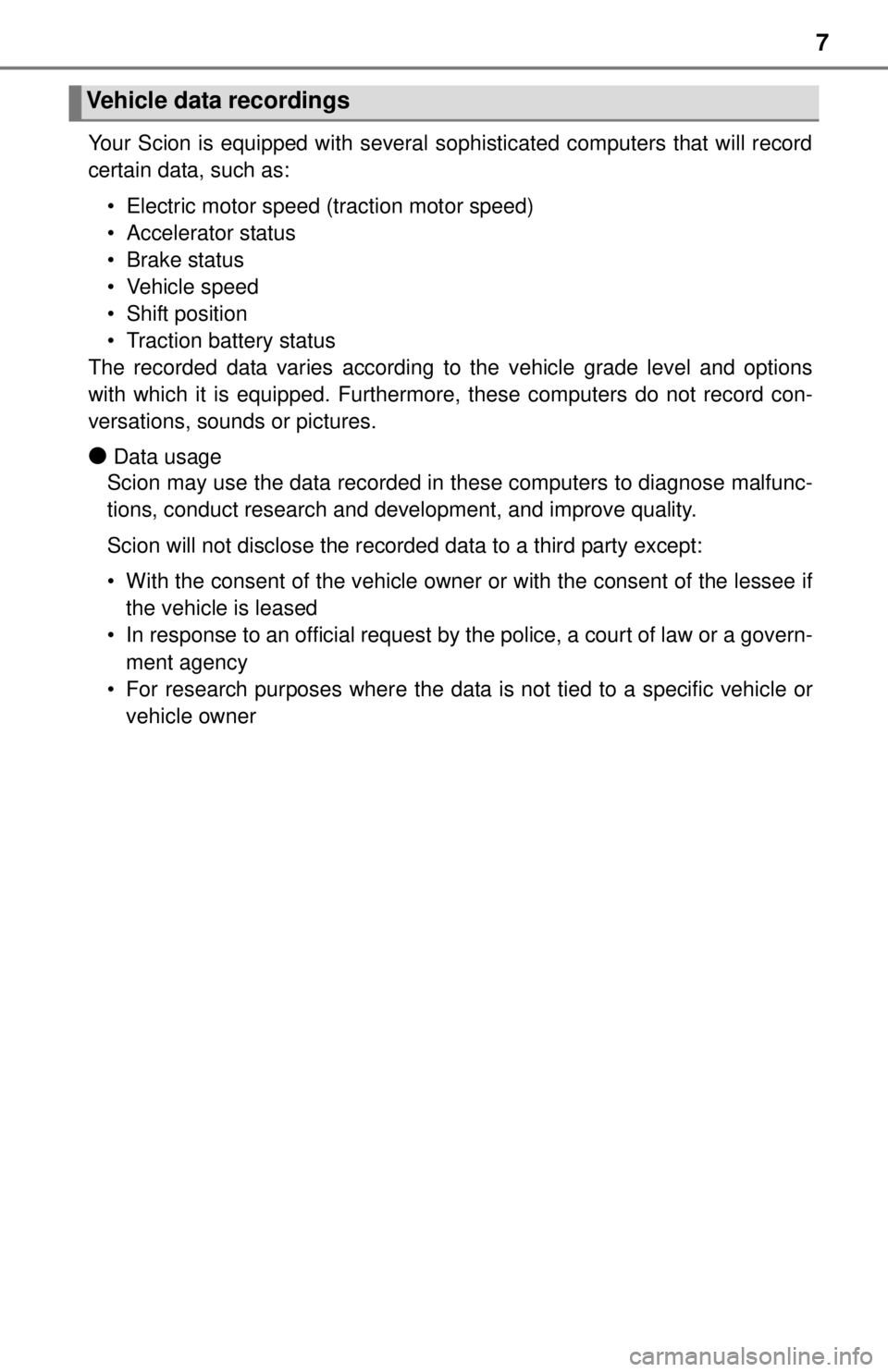
7
Your Scion is equipped with several sophisticated computers that will rec\
ord
certain data, such as:• Electric motor speed (traction motor speed)
• Accelerator status
• Brake status
• Vehicle speed
• Shift position
• Traction battery status
The recorded data varies according to the vehicle grade level and options
with which it is equipped. Furthermore, these computers do not record con-
versations, sounds or pictures.
●Data usage
Scion may use the data recorded in these computers to diagnose malfunc-
tions, conduct research and development, and improve quality.
Scion will not disclose the recorded data to a third party except:
• With the consent of the vehicle owner or with the consent of the lessee if
the vehicle is leased
• In response to an official request by the police, a court of law or a govern- ment agency
• For research purposes where the data is not tied to a specific vehicle or vehicle owner
Vehicle data recordings
Page 71 of 444
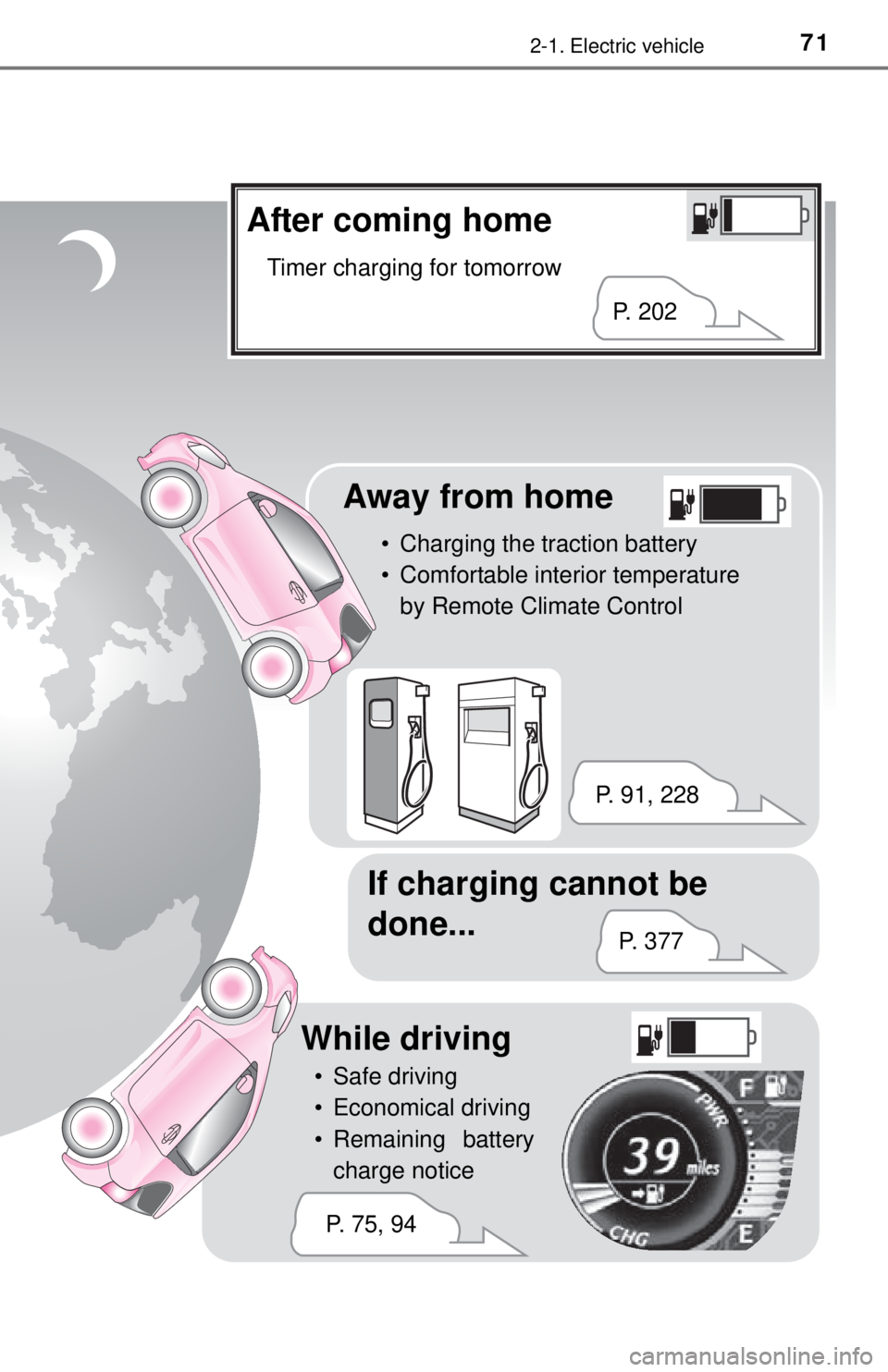
712-1. Electric vehicle
After coming home
Timer charging for tomorrow
Away from home
• Charging the traction battery
• Comfortable interior temperature by Remote Climate Control
If charging cannot be
done...
P. 202
P. 91, 228 P. 3 7 7
While driving
• Safe driving
• Economical driving
• Remaining batterycharge notice
P. 75, 94
Page 72 of 444
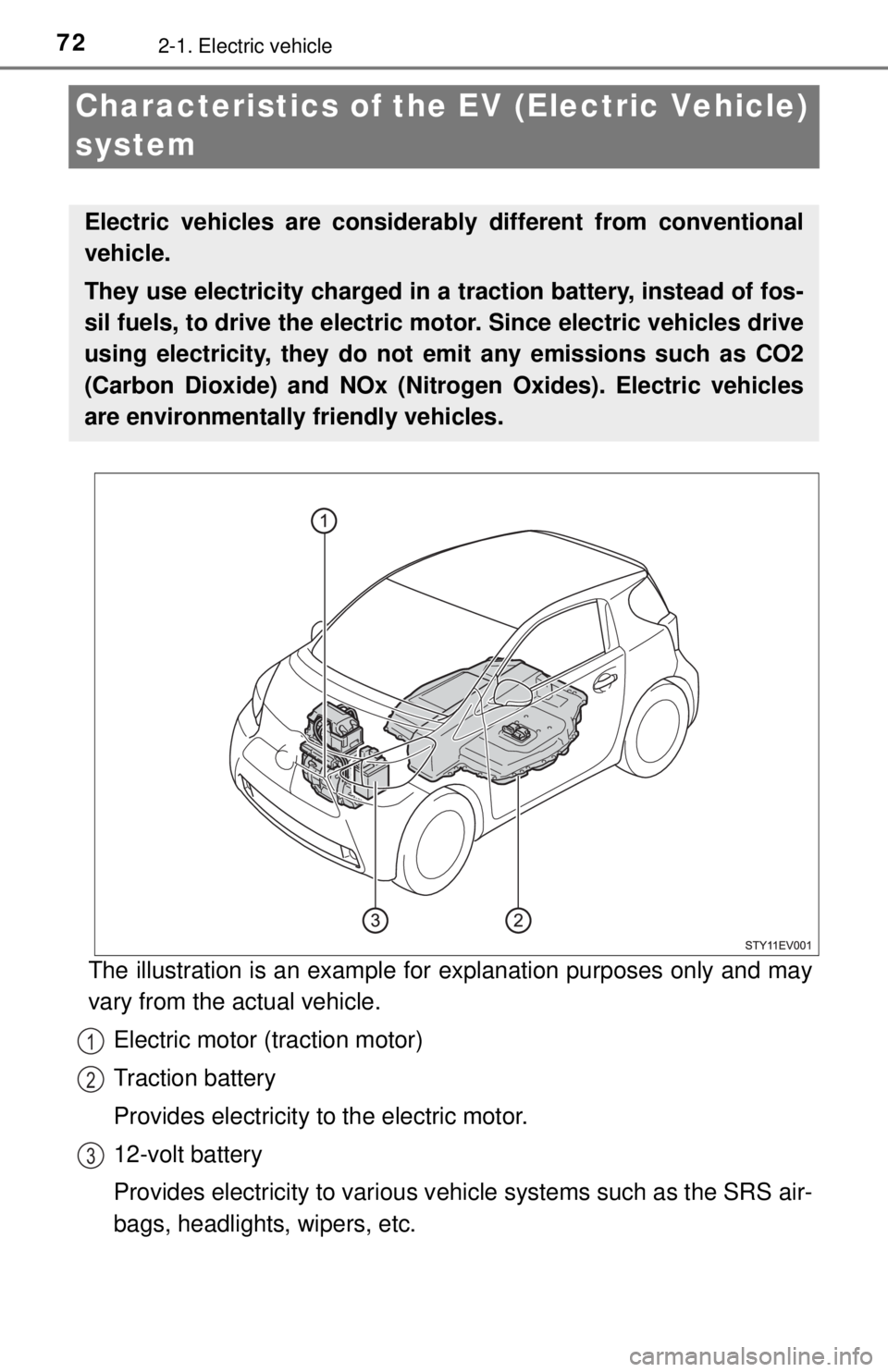
722-1. Electric vehicle
Characteristics of the EV (Electric Vehicle)
system
The illustration is an example for explanation purposes only and may
vary from the actual vehicle.Electric motor (traction motor)
Traction battery
Provides electricity to the electric motor.
12-volt battery
Provides electricity to various v ehicle systems such as the SRS air-
bags, headlights, wipers, etc.
Electric vehicles are considerab ly different from conventional
vehicle.
They use electricity charged in a traction battery, instead of fos-
sil fuels, to drive the electric motor. Since electric vehicles drive
using electricity, they do not emit any emissions such as CO2
(Carbon Dioxide) and NOx (Nitroge n Oxides). Electric vehicles
are environmentally friendly vehicles.
1
2
3
Page 73 of 444

732-1. Electric vehicle
2
EV system
◆When braking (regenerative braking)
The electric motor (traction motor) charges the traction battery.
The driving range can be extended by actively using this regenera-
tive braking to store electricity in the traction battery.
◆Charging
The electric vehicle is driven using electricity, received from an
external power source, that is stored in the traction battery. Not only
public charging stations, but also household electrical outlets can
be used for charging. Procedures are different from refueling a con-
ventional vehicle. Theref ore, make sure to read the following thor-
oughly.
● Charging equipment ( P. 84)
● Power sources that can be used ( P. 88)
● How to charge your vehicle ( P. 181, 195)
● If charging cannot be done ( P. 377)
● Inspecting the charging cable ( P. 262)
Page 74 of 444
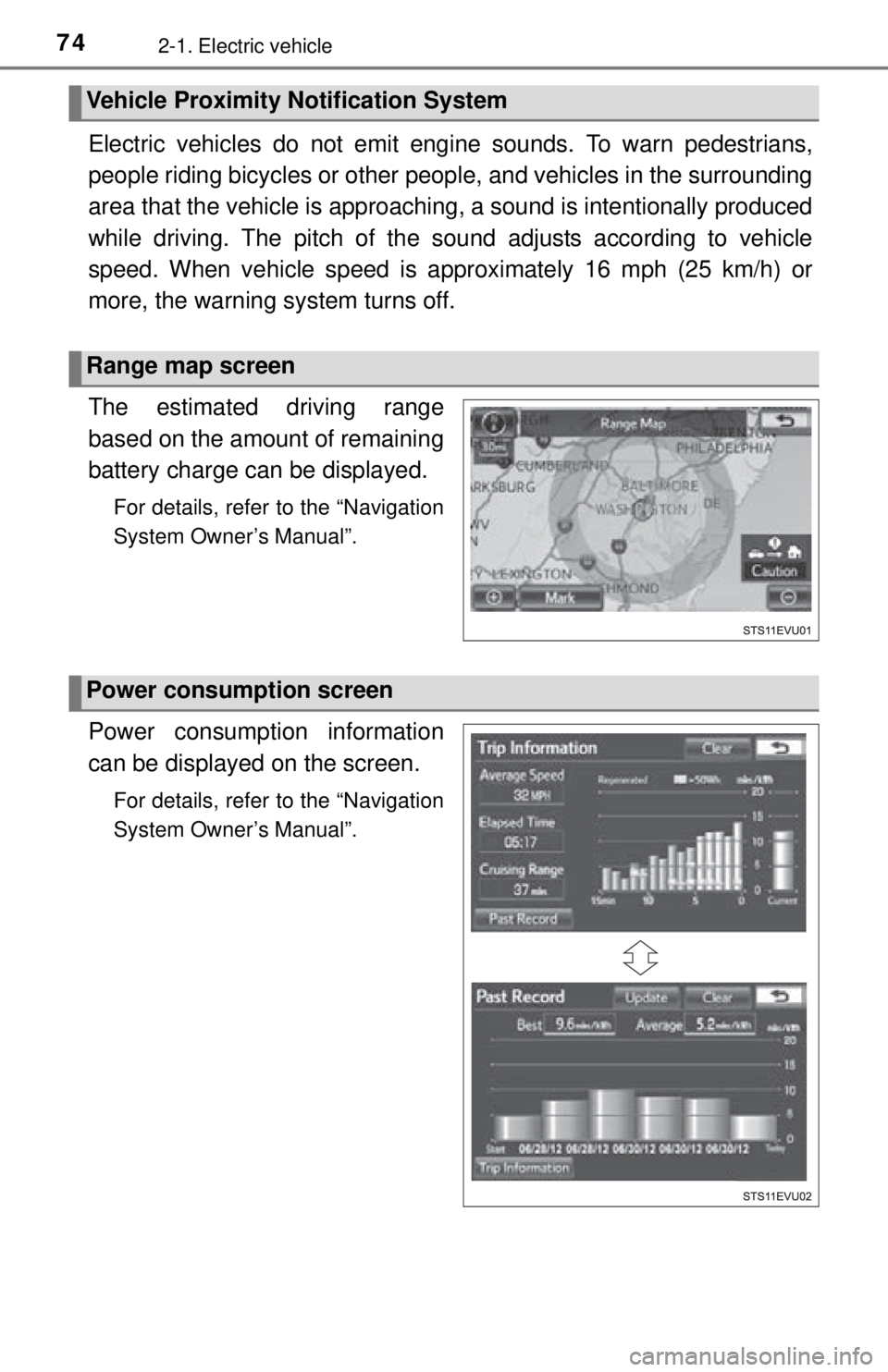
742-1. Electric vehicle
Electric vehicles do not emit engine sounds. To warn pedestrians,
people riding bicycles or other peop le, and vehicles in the surrounding
area that the vehicle is approaching , a sound is intentionally produced
while driving. The pitch of the s ound adjusts according to vehicle
speed. When vehicle speed is approximately 16 mph (25 km/h) or
more, the warning system turns off.
The estimated driving range
based on the amount of remaining
battery charge can be displayed.
For details, refer to the “Navigation
System Owner’s Manual”.
Power consumpti on information
can be displayed on the screen.
For details, refer to the “Navigation
System Owner’s Manual”.
Vehicle Proximity Notification System
Range map screen
Power consumption screen
Page 75 of 444

752-1. Electric vehicle
2
EV system
■Regenerative braking
In the following situations, kinetic energy is converted to electric energy and
deceleration force can be obtained in conjunction with the recharging of the
traction battery.
●The accelerator pedal is released while driving with the shift lever in D, S or
B.
● The brake pedal is depressed while driving with the shift lever in D, S or B.
If “REGENERATIVE BRAKING LIMITED” appears on the multi-information
display, refer to P. 347.
■ 12-volt battery recharging
The 12-volt battery is charged from the traction battery when the EV system
is operated or while the traction battery is being charged.
If the vehicle has not been used for a long time, the 12-volt battery may
become low due to self-discharge. If this occurs, follow the correct proce-
dures. ( P. 386)
■ When not using the vehicle for an extended period of time
P. 191
■ Charging the traction battery
Be sure to maintain the traction battery charge level suitable for your driving
needs.
If the traction battery fully discharges, the vehicle cannot be driven at all.
When the battery becomes low, charge it as soon as possible.
■ If the traction battery becomes low
●If the SOC (State of Charge) warning light flashes, the power used by the air
conditioning system will automatically be restricted and the traction battery’s
remaining charge will be distributed for driving the vehicle. If the traction bat-\
tery fully discharges, driving will not be possible. When the battery becomes
low, charge it as soon as possible.
Page 76 of 444
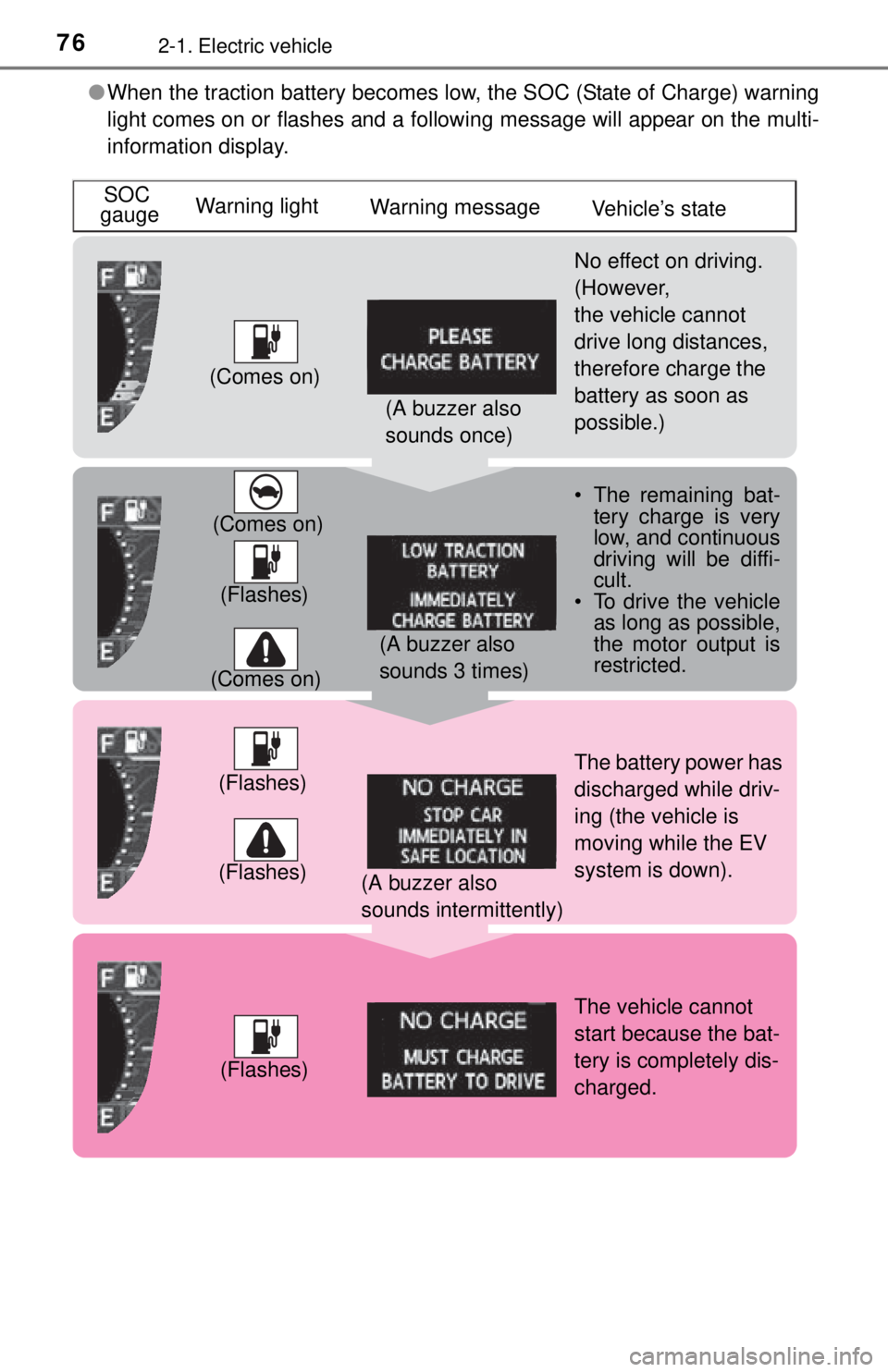
762-1. Electric vehicle
●When the traction battery becomes low, the SOC (State of Charge) warning
light comes on or flashes and a following message will appear on the multi-
information display.
SOC
gauge Warning light
Warning message
Vehicle’s state
No effect on driving.
(However,
the vehicle cannot
drive long distances,
therefore charge the
battery as soon as
possible.)
• The remaining bat- tery charge is very
low, and continuous
driving will be diffi-
cult.
• To drive the vehicle
as long as possible,
the motor output is
restricted.
The battery power has
discharged while driv-
ing (the vehicle is
moving while the EV
system is down).
The vehicle cannot
start because the bat-
tery is completely dis-
charged.
(Comes on)
(Comes on)
(Comes on)
(Flashes)(Flashes)
(Flashes)
(Flashes) (A buzzer also
sounds once)
(A buzzer also
sounds 3 times)
(A buzzer also
sounds intermittently)
Page 77 of 444
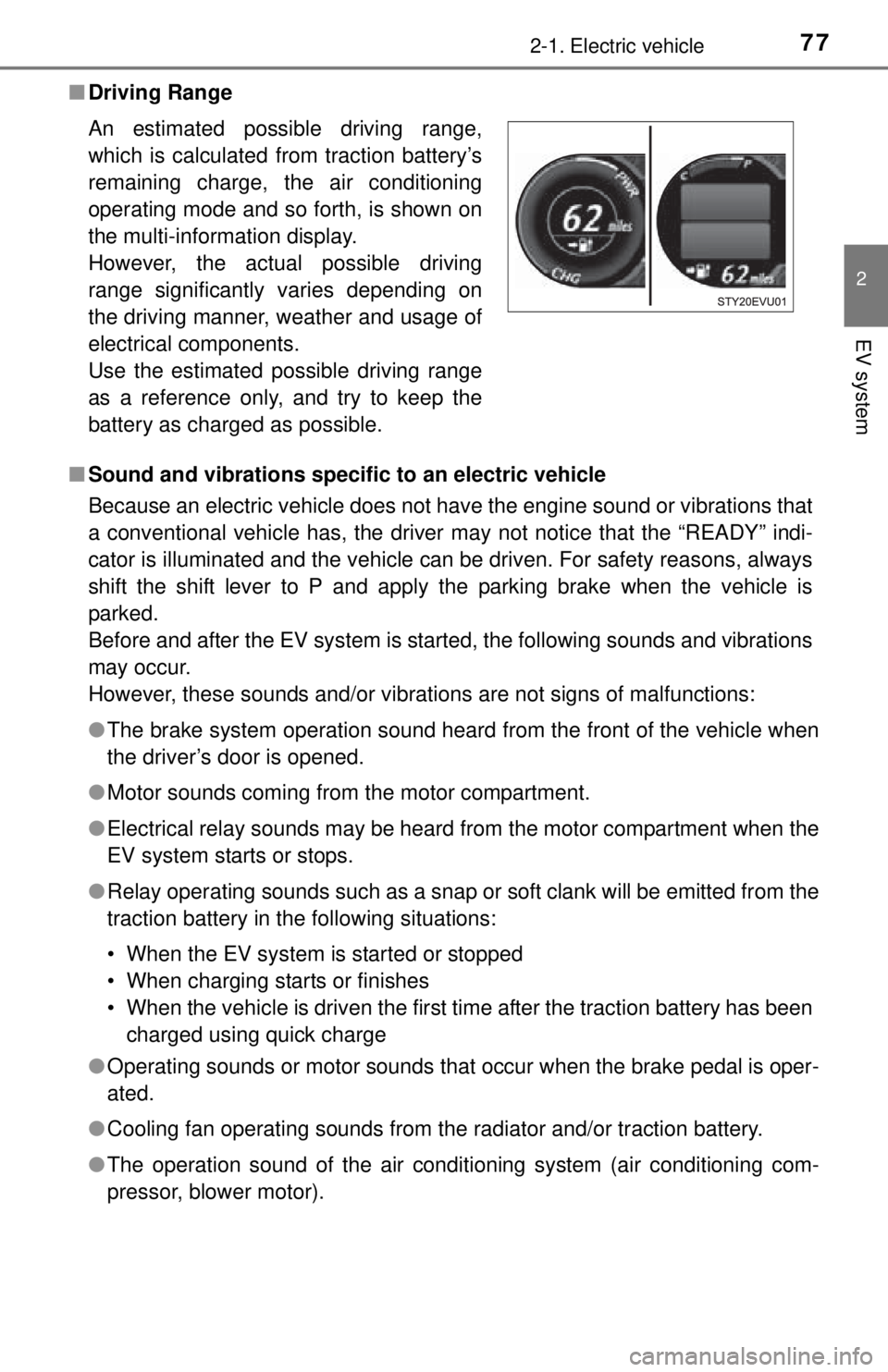
772-1. Electric vehicle
2
EV system
■Driving Range
■ Sound and vibrations speci fic to an electric vehicle
Because an electric vehicle does not have the engine sound or vibrations that
a conventional vehicle has, the driver may not notice that the “READY” indi-
cator is illuminated and the vehicle can be driven. For safety reasons, always
shift the shift lever to P and apply the parking brake when the vehicle is
parked.
Before and after the EV system is started, the following sounds and vibrations
may occur.
However, these sounds and/or vibrations are not signs of malfunctions:
● The brake system operation sound heard from the front of the vehicle when
the driver’s door is opened.
● Motor sounds coming from the motor compartment.
● Electrical relay sounds may be heard from the motor compartment when the
EV system starts or stops.
● Relay operating sounds such as a snap or soft clank will be emitted from the
traction battery in the following situations:
• When the EV system is started or stopped
• When charging starts or finishes
• When the vehicle is driven the first time after the traction battery has been
charged using quick charge
● Operating sounds or motor sounds that occur when the brake pedal is oper-
ated.
● Cooling fan operating sounds from the radiator and/or traction battery.
● The operation sound of the air conditioning system (air conditioning com-
pressor, blower motor).
An estimated possible driving range,
which is calculated from traction battery’s
remaining charge, the air conditioning
operating mode and so forth, is shown on
the multi-information display.
However, the actual possible driving
range significantly varies depending on
the driving manner, weather and usage of
electrical components.
Use the estimated possible driving range
as a reference only, and try to keep the
battery as charged as possible.
Page 79 of 444
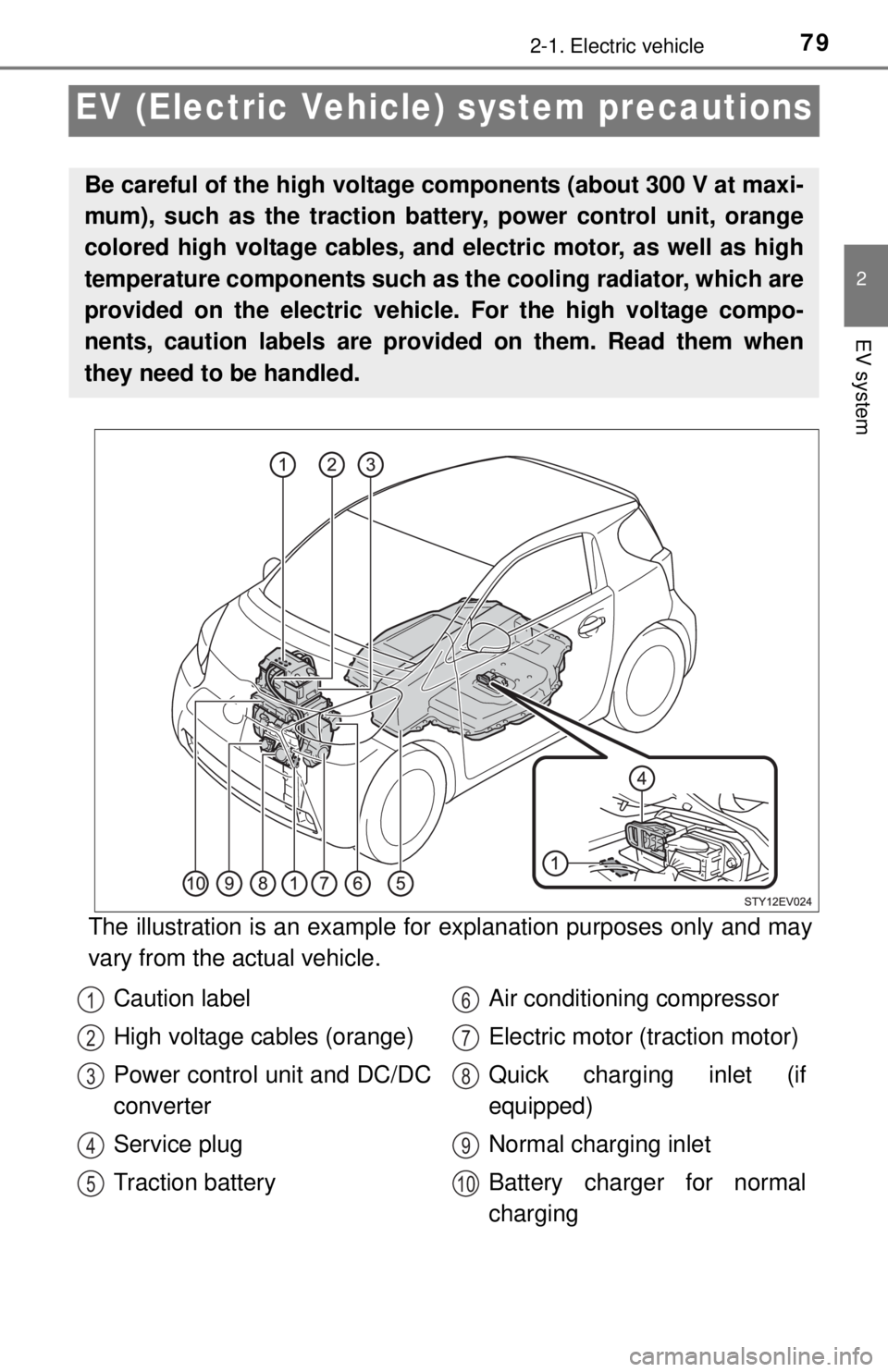
792-1. Electric vehicle
2
EV system
EV (Electric Vehicle) system precautions
The illustration is an example for explanation purposes only and may
vary from the actual vehicle.
Be careful of the high voltage components (about 300 V at maxi-
mum), such as the traction battery, power control unit, orange
colored high voltage cables, and electric motor, as well as high
temperature components such as the cooling radiator, which are
provided on the electric vehicle. For the high voltage compo-
nents, caution labels are provided on them. Read them when
they need to be handled.
Caution label
High voltage cables (orange)
Power control unit and DC/DC
converter
Service plug
Traction battery Air conditioning compressor
Electric motor (traction motor)
Quick charging inlet (if
equipped)
Normal charging inlet
Battery charger for normal
charging1
2
3
4
5
6
7
8
9
10